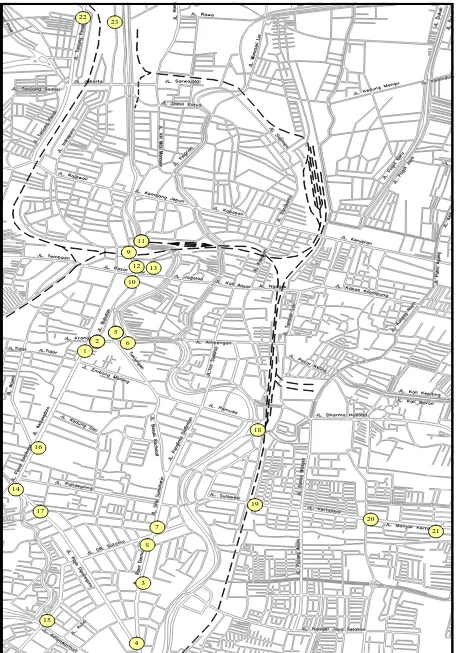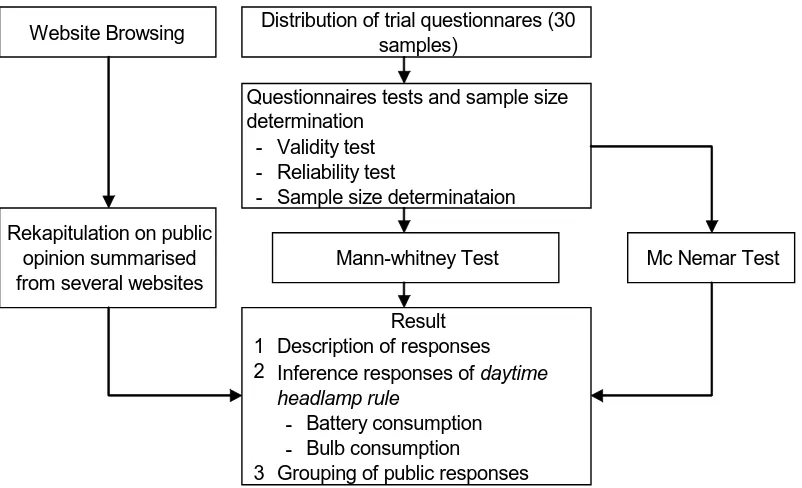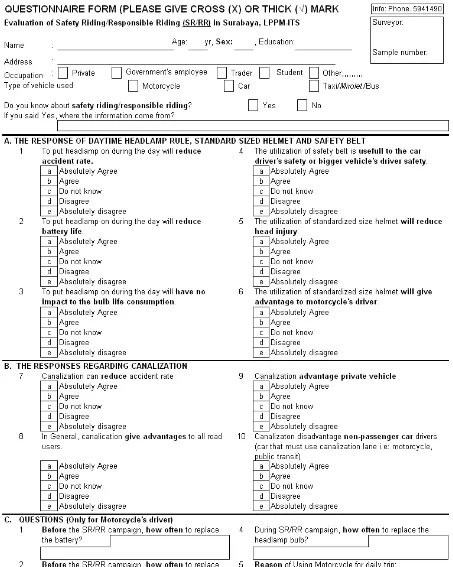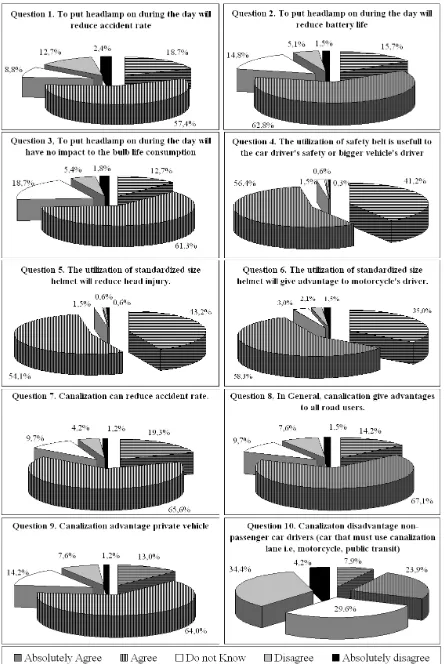The Responses of Road Users on Safety Riding Campaign in Surabaya
Anak Agung Gde Kartika1, Hera Widyastuti1, Wahju Herijanto1, Cahya Buana1,
Abstract: The implementation of safety riding in Surabaya in 2006 featuring some actions including canalization (kanalisasi), daytime headlamp rule, safety belt rule and the standardized helmet are viewed by some as not suitable with the existing condition. Canalization causes unfairness among road users. The canalization lane, mandatory for vehicle such as motorcycle and public transit (bus and mikrolet) tends to suffer bigger degree of saturation compared to the others. Not to mention the indication of overuse of battery and shorter bulbs life time due to the daytime headlamp rule application. Although the evaluation of the safety riding campaign covers several aspects, this paper only discuss the responses of road users to safety riding campaign especially canalization and daytime headlamp rule. The data collecting process is carried out by distributing 332 questionnaires to all road users including motorcyclists, car drivers and public transit users. The instant responses are also collected and summarized from several websites. Furthermore, the descriptive and inference statistical analysis are deployed to give the common view of response of road users as well as tabulate the summary of website-posted response. The results show that, generally most of road users support the safety riding campaign. On the contrary, most of road users agree that the daytime headlamp rule did consume more both battery and bulbs. Meanwhile, the website-posted responses varies between agree and disagree with their own reasons.
Keywords: response, safety riding, Surabaya, canalization, daytime headlamp rule.
Introduction
During these recent years, starting in 2003, the Surabaya Local Police Department have been im-plementing new rule called canalization at several road links within the city of Surabaya [1] including several street (Jl) and traffic light (TL): 1). Jl. Pra-ban- Jl. Bubutan; 2). TL of Jl. Blauran- Jl. Krang-gan; 3). Jl. Raya Darmo; 4). TL of Jl. Raya Darmo-Jl. Diponegoro; 5). TL of Jl Gemblongan-Jl. Tunjungan; 6). TL of Jl. Tunjungan- Jl. Gentengkali; 7). TL of Jl Raya Darmo-Jl. Polisi Istimewa; 8). TL of Jl. Raya Darmo-Jl. Dr Sutomo; 9). Jl. Bubutan-Jl. Kebonrojo; 10). TL of Jl. Bubutan-Jl. Tembaan; 11). TL of Jl. Veteran-Jl. Kebonrojo; 12). Jl. Pahlawan (west side); 13). Jl. Pahlawan (east side); 14). TL of Jl. Pasar Kupang-Jl. Banyuurip; 15). TL of Jl. Adityawarman-Jl. Indragiri; 16). T.L. Adityawarman-Jl. Pasar Kembang; 17). TL of Jl. Kartini-Diponegoro; 18). Jl. Raya Gubeng; 19). Jl Raya Kertajaya; 20). Jl. Manyar Kertoarjo 1; 21). Jl. Manyar Kertoarjo 2; 22). Jl. Perak Timur; and 23). Jl. Kalimas Baru, (see Figure 1).
1 Department of Civil Engineering ITS Surabaya, East Java,
Indonesia, Phone: +62+315941490 E-mail: [email protected]
Note: Discussion is expected before November, 1st 2008, and will be published in the “Civil Engineering Dimension” volume 11, number 1, March 2009.
Received 22 April 2008; revised 17 June 2008; accepted 18 June 2008
The canalization itself, is defined as the utilization of nearside lane within the road for non-private car vehicle including, city bus, motorcycle, microbus (mikrolet), bicycle and man-drawn chariot if any. According to the Surabaya Police Department, the canalization is based on the PP (Government Regu-lation) No. 43/1993 section 61 subsection 1 which says that:
“Pada lajur yang memiliki dua atau lebih lajur searah, kendaraan yang berkecepatan lebih ren-dah daripada kendaraan lain harus mengambil lajur kiri”. (In English: In a road link with two or more same direction lane, slower running vehicle must use left lane)
Despite debatable legal aspect above, this program (campaign) is then continued in the year 2004 with additional slogan of “klik” for both safety belt and helmet. This additional slogan is to emphasize the existing regulation mentioned in Indonesian Traffic and Road Transport Act (UU LLAJ) No 14/1992 section 23 subsection 1e and section 23 subsection 2.
2
1
3
4 2
5
6
7
8 5
9
10 11
12 11
13
14
15 16
17
18
19
20
21 22
23
on during the daylight driving. These policies appa-rently adopt other countries’ regulation as it is, without considering the surrounding situation i.e. the existence of mist or smoke [3, 4].
The implementation of safety riding campaign is found controversial, especially both the canalization rule and daytime headlamp rule. Kartika [5] stated that canalization produce unfairness in term of space utilization of road. Moreover, the daytime headlamp rule is predicted to trigger the overuse of vehicle parts especially battery and headlamp bulbs. Some serial analyses are needed to evaluate the safety riding campaign comprehensively as presented in Figure 2. This paper will discuss the responses of road users regarding safety riding campaign for both canalization and daytime headlamp rule only (see shaded box).
Goals
As explained previously, the goals of this paper are as follows:
1. Are there any differences in the response of canalized vehicle drivers and non-canalized vehicle drivers? What are the responses of road users regarding the implementation of canaliza-tion?
2. What is the response of road users regarding the daytime headlamp rule?
3. What are the general public responses regarding the implementation of safety riding posted in website?
Methodology
The first step of this research is simultaneously doing both the internet browsing to find instant responses in website and distributing the trial questionnaire to various respondents regarding the safety riding campaign in Indonesia especially in Surabaya. Based on the trial questionnaire above, the validity and reliability analysis test are carried out before the sample size determination. Meanwhile the public opinion on safety riding campaign is summarized to eventually draw common responses.
The next step is to test the sample group with Man-Whitney test [6] to know whether there are diffe-rence responses between sample groups (motor-cyclist, car driver, public transport users). It is then followed by figuring out the description of sample’s responses.
Furthermore, the cross tab analysis and McNemar test [6] are used to analyze the condition before and during the implementation of daytime headlamp rule regarding its impact to the battery life and headlamp bulb lifetime. However, the analysis is
only based on the experience of road users not based on a specific research. In general, the methodology of this paper is presented in Figure 3.
The Questionnaire form used to collect the responses of road users regarding the safety riding campaign is presented in Figure 4.
The result of trial questionnaire of 30 samples is presented in Table 1.
Sample Size
Since Surabaya is an open city which means that road users is not only originated from Surabaya but is also originated from any other city other than Surabaya, therefore the population of road users is considered as infinite population so that the sample size determination equation developed by Cochran [7] will be used to obtain the proper number of samples. According to Cochran [7] the number of samples depends on the proportion of trial samples (p and q) to choose their choices. Among the 30 trial samples, 22 samples (73.33%=p) support the canali-zation program and only 8 samples (26.67%=q) do not support the canalization program. Meanwhile, among 30 trial samples, 29 samples (96.67%=p) support the safety riding campaign in general and only 1 sample (3.33%=q) do not support the safety riding campaign. Therefore, the number of sample needed is the biggest value between these two
numbers of samples below (α=5%, Z=1.96):
Number of samples based on responses regarding canalization:
Number of samples based on responses regarding Safety Riding/Responsible Riding campaign:
samples
Therefore, the number of samples needed is at least 300 samples.
Reliability and Validity test
The number of samples collected is 332 samples which are larger than that specified before (at least 300 samples). The Cronbach’s Alpha [8] is used to determine the reliability of the questionnaire and validity of the questions within the questionnaire. The output of reliability and validity analysis are
Daytime headlamp rule
The Evaluation of Safe Riding Campaign in Surabaya
T
Standard Size Helmet Regulation
Fig. 2. The framework of evaluation of safety riding campaign.
Website Browsing
-1 Description of responses 2
- Battery consumption - Bulb consumption
3 Grouping of public responses
Mc Nemar Test Distribution of trial questionnares (30
samples)
Questionnaires tests and sample size determination
Validity test Reliability test
Result
Inference responses of daytime headlamp rule
Sample size determinataion
Rekapitulation on public opinion summarised from several websites
Mann-whitney Test
T
a
bl
e
1
.
Th
e
d
a
ta
o
f
tr
ia
l
q
u
es
ti
o
n
n
a
ir
e
N
ot
e
SMA
: Se
n
io
r H
ig
h S
chool
, S
1
: G
ra
d
u
ate
, S2
: Po
st
G
ra
d
u
at
e,
S
3
: D
o
cto
r/P
h
D
Table 2. Reliability test, (output SPSS [8])
N %
Cases Valid 326 98,2
Excluded(a) 6 1,8
Total 332 100,0
a Listwise deletion based on all variables in the pro-cedure.
Cronbach's Alpha N of Items
0,691 10
Table 3. Validity test, (output SPSS [8])
Scale Table 2 show that the Cronbach’s Alpha is 0.691 thus it can be concluded that the questionnaire is reliable since it is bigger than 0.6 [8]. Meanwhile, Table 3 show that the validity of all questions within the questionnaire form are valid since the Corrected
Item-Total Correlation of each questions >rtable=0.11
[9].
Analysis
Description of Responses
The grouping of samples is predefined first before the descriptive analysis. The group itself is defined based on ‘what impact to whom’ approach. Regar-ding the canalization, two groups have been deter-mined as follow:
1. Group 1, consists of samples (respondents) which drive canalization-lane mandatory vehicle i.e.: motorcycle, public transport (bus, mikrolet, taxi) and pedestrian which is commonly as public transport users.
2. Group 2, consists of samples which drive non-canalized-lane mandatory vehicle i.e.: passenger car.
Meanwhile, regarding to other safety riding features campaign i.e. the daytime headlamp rule, standar-dized helmet, the group of sample is a little bit different than those applied in previous group. The number of group is still the same, which is divided into two groups including:
1. Group 1, consists of samples which is directly affected by those regulation in this case motor-cyclist.
2. Group 2, consists of samples of non-motorcyclist.
After the groups of samples have been defined, the non parametric Mann-Whitney test [6] is used to test whether or not there is a significantly different res-ponse among groups for specific matters. If the difference does exist, the descriptive analysis must be presented separately or clustered based on each group. On the other hand, if there is no difference found, the descriptive analysis can be assumed representing all samples.
Safety Riding (daytime headlamp rule and standardized helmet)
The questions relating to the responses of road users regarding the daytime headlamp rule and standar-dized helmet are found in question number 1 to 6 of questionnaire shown in Figure 4. The Mann-Whit-ney test [6] is deployed with the following hypo-theses:
H0: There are no different responses between
motorcyclist and non motorcycle driver regar-ding the daytime headlamp rule and standar-dized helmet.
H1 : There are different responses between
motor-cyclist and non motorcycle driver regarding the daytime headlamp rule and standardized helmet.
The conclusion will be based on the Asymptotic
Significance value [6]. The H0 will be supported if the
probability of Asymptotic Significance value>0.05.
On the contrary, the H0 will be rejected and H1 is
supported if the probability of Asymptotic Signifi-cance value<0.05. The result of Mann-Whitney test is presented in Table 4.
Based on the result as presented in Table 4, it can be seen that the probability of asymptotic values are bigger than 0.05 so that it can be concluded that there is no significantly different responses between Group 1 and Group 2 regarding the daytime head-lamp rule and standardized size helmet regulation.
Safety Riding (canalization)
The questions relating to the responses of road users regarding the canalization are found in question number 7 to 10 of questionnaire shown in Figure 4. The Mann-Whitney test is deployed with these following hypotheses:
H0: There are no different responses between
canalization-lane mandatory vehicle driver and non-canalization-lane mandatory vehicle driver regarding the canalization.
H1 : There are different responses between
Similarly, the conclusion will be based on the
Asymptotic Significance value. The H0 will be
sup-ported if the probability of Asymptotic Significance
value>0.05. On the contrary The H0 will be rejected
and H1 is supported if the probability of Asymptotic
Significance value<0.05. The result of
Mann-Whit-ney test is presented in Table 5.
Based on the result as presented in Table 5, it can be seen that the probability of asymptotic significance value is higher than 0.05 thus it can be concluded that there is no significantly different responses between Group 1 and Group 2 regarding the canalization. Therefore, the descriptive analysis is not necessarily clustered into two groups. The des-criptions of responses of all samples are presented in Figure 5.
Table 4. Mann-Whitney test of samples regarding the daytime headlamp rule and standardized size helmet [6]
Category N Mean Rank Sum of Ranks
Quest1 1,00 283 166,58 47143,50
2,00 47 158,97 7471,50
Total 330
Quest2 1,00 283 164,79 46635,50
2,00 47 169,78 7979,50
Total 330
Quest3 1,00 282 164,65 46431,00
2,00 47 167,11 7854,00
Total 329
Quest4 1,00 283 165,33 46787,00
2,00 47 166,55 7828,00
Total 330
Quest5 1,00 283 164,32 46501,50
2,00 47 172,63 8113,50
Total 330
Quest6 1,00 283 167,59 47428,00
2,00 46 149,07 6857,00
Total 329
Test Statistics (a)
Quest1 Quest2 Quest3 Quest4 Quest5 Quest6
Mann-Whitney U 6343,500 6449,500 6528,000 6601,000 6315,500 5776,000 Wilcoxon W 7471,500 46635,500 46431,000 46787,000 46501,500 6857,000
Z -,567 -,385 -,189 -,094 -,636 -1,412
Asymp. Sig. (2-tailed) 0,571 0,700 0,850 0,925 0,525 0,158
a Grouping Variable: Category
Table 5. Mann-Whitney test of samples regarding the Canalization [6]
Category N Mean Rank Sum of Ranks
Quest7 1,00 283 169,23 47891,50
2,00 47 143,05 6723,50
Total 330
Quest8 1,00 283 168,19 47599,00
2,00 47 149,28 7016,00
Total 330
Quest9 1,00 282 166,67 47001,00
2,00 47 154,98 7284,00
Total 329
Quest10 1,00 281 164,00 46083,50
2,00 47 167,50 7872,50
Total 328
Test Statistics (a)
Quest7 Quest8 Quest9 Quest10
Mann-Whitney U 5595,500 5888,000 6156,000 6462,500
Wilcoxon W 6723,500 7016,000 7284,000 46083,500
Z -2,071 -1,514 -,917 -,245
Asymp. Sig. (2-tailed) 0,038 0,130 0,359 0,807
Inference Analysis of Daytime Headlamp Rule
The description of responses of road users regarding the indications that daytime headlamp rule can reduce both battery and bulbs life is presented in Figure 6. The inferences about these indications are discussed more in depth as follows.
a. Indication of overuse of battery (reduce battery life)
As shown in Figure 6, it is clear that many of samples state that they have no any idea about battery and bulb life before and after the application of daytime headlamp rule. This can be because they do not follow the rule or they do not care about those matters. Additionally, samples not riding motorcycle will absolutely have no idea about these matters. Therefore, the inference analysis will be addressed to the samples that really experienced and concern about those matters.
Of all samples collected, there are only 93 samples (28.1%) that really experience and concern about battery life history of their motorcycle (see Table 6). The inference analysis is then carried out based on these samples. The conclusion is based on the following hypotheses:
H0 : Battery life before and after applying
daytime headlamp rule is the same (there is no significant impact)
H1 : Battery life before and after applying
daytime headlamp rule is not the same (there is significant impact), battery life is significantly reduced.
As indicated in Table 6, the Asymptotic Signi-ficance value is found 0.000 which is smaller than
0.05 (0.000<0.05) so that the H0 is rejected. This
means that the daytime headlamp rule in Surabaya does reduce battery life significantly.
b. Indication of overuse of bulbs
Similar with the previous analysis, the indication of overuse of bulbs analysis is also addressed to the samples that really experienced and concern about those matters.
Of all samples collected, there are only 84 samples (25.38%) that really experience and concern about bulb life history of their motorcycle (see Table 7). The inference analysis is then carried out based on these samples. The conclusion is based on these following hypotheses:
H0: Bulbs life before and after applying daytime
headlamp rule is the same (there is no significant impact)
H1: Bulbs life before and after applying daytime
headlamp rule is not the same (there is significant impact), bulbs life is significantly reduced.
As indicated in Table 7, the Asymptotic Signi-ficance value is found 0.000 which is smaller than
0.05 (0.000<0.05) so that the H0 is rejected. This
means that the daytime headlamp rule in Sura-baya does reduce bulbs life significantly.
Public Opinion from Websites
Some public opinions obtained from several websites [10, 11, 12] are generally divided into two side of opinions which are agree or disagree. The summary of those opinions are presented in Table 8.
Fig. 6. The Responses of road users regarding the indication that daytime headlamp rule can reduce battery life and bulbs
Table 6. Before and after of daytime headlamp rule regarding overuse of battery life. [6]
1=normal (unaffected) 2=shorter battery life
Case Processing Summary Cases
Valid Missing Total
N Percent N Percent N Percent
AccuBefore * BattAfter 93 100,0% 0 ,0% 93 100,0%
BattBefore * BattBefore Crosstabulation
Count
BattAfter
1,00 2,00 Total
BattBefore 1,00 46 47 93
Total 46 47 93
BattBefore & BattAfter
BattBefore BattAfter
1 2
1 46 47
2 0 0
Test Statistics (b)
BattBefore & BattAfter
N 93
Chi-Square(a) 45,021
Asymp. Sig. 0,000
a Continuity Corrected b McNemar Test
Table 7. The before and after analysis of the impact of daytime headlamp rule regarding bulbs life time. [6]
1=normal (unaffected) 2=shorter bulbs life
Case Processing Summary Cases
Valid Missing Total
N Percent N Percent N Percent
BulbBefore * BulbAfter 84 100,0% 0 ,0% 84 100,0%
BulbBefore * BulbAfter Crosstabulation
Count
BulbAfter
1,00 2,00 Total
BulbBefore 1,00 36 48 84
Total 36 48 84
BulbBefore & BulbAfter
BulbAfter BulbBefore
1 2
1 36 48
2 0 0
Test Statistics (b)
BulbBefore & BulbAfter
N 84
Chi-Square(a) 46,021
Asymp. Sig. 0,000
Conclusions
Based on the analysis above, the following conclusion can be drawn:
1. In general, there are no difference responses between canalized vehicle drivers and non-canalized vehicle drivers. Additionally, most of road users support the safety riding campaign including canalization program. Most of road users are found to agree with canalization.
2. According to samples, the daytime headlamp rule does reduce battery as well as bulbs life.
3. There are actually two sides of public opinion summarized from website regarding safety riding campaign which are agree or disagree. The reasons of their opinion depend on the availa-bility of facility and infrastructure, on-duty officers’ availability, officer’s integrity, road user’s safety, the overuse of resources, the conspicuity of motorcycle, and the behavior of road users themselves.
References
1. Polwiltabes Surabaya, Presentation of the Chief
of Traffic Division of Local Police Department Surabaya, the Implementation of Safety Riding Program, 2006.
2. http://jatim.polri.go.id/index.php?option=com_co ntent&task=view&id=596, Saatnya Saling Meng-hargai, retrieved on 3 December 2007.
3. http://www.indomedia.com/bpost/022007/27/Hot Line/Line1.htm, Jalan Meriah, Mata Jadi Melek, retrieved on 9 December 2007
4. Rahim, M., Terangi Siang dengan Lampu
Ken-daraan Anda, http://www.panyingkul.com/view. php?id=324&jenis=kabarkita, retrieved on 9 January 2008.
5. Kartika, A.A.G., The Evaluation of Canalization from the Legal, Technical and Operational Point
of View, August 2004, The Proceeding of 7th
Symposium of The Inter-University Transporta-tion Study Forum (FSTPT), University of Parahyangan, Bandung, 2004.
6. Santoso, S. Nonparametric Statistic, second
printing, PT. Elex Media Komputindo, Jakarta, 2003.
7. Cochran, W.G., Sampling Techniques, 1963, in
Glenn D. Israel, document PEOD6, Agricultural Education and Communication Department, Florida Cooperative Extension Service, Institute of Food and Agricultural Sciences, University of Florida, http://edis.ifas.ufl.edu., retrieved on 19 November 2007.
8. Sujianto, A.E. Application of Statistic with SPSS,
Prestasi Pustaka, Jakarta, 2007.
9. Sugiyono and Wibowo E. Statistic for Research and Its Application By Using SPSS 10.00 for Windows, 4th printing, Alfabeta, Bandung, 2004. 10.
http://www.detikforum.com/archive/index.php/t-351.html, retrieved on 9 January 2008.
11. http://mertanus.wordpress.com/2007/04/25/perat uran-baru-ditlantas-polda-metro-jaya/retrieved on 9 January 2008.
12. http://bennychandra.com/2005/09/06/nyalakan-lampu-sepeda-motor-di-siang-hari/ retrieved on 9 January 2008.
Table 8. Public opinion regarding the safety riding from several websites.
Reason for agree Reason for disagree
Nearside lane is safer for motorcycle since some motorcycles are found doing the overtaking and crossing with proper signals. .
Safety riding disadvantage motorcycles
Safety riding is applied on main road only Too pro to car driver. In Indonesia, many of motorcycle drivers tend to break the
law (traffic law)
Motorcycle is in the same lane with other vehicles, including big vehicle such us city bus.
The behavior of most motorcyclists is likely the same with uneducated public transit driver.
The lane provided for canalization is too narrow.
During the application, the unfairness treatment still often found when cars somehow are allowed to use canalization lane. But when the opposite take place the motorcycle driver will be punished with the ticket or fine.
There is a possibility that safety riding is used for illegal
purpose by less-integrity authorized personnel. The same regulation is found in European country. Reduce battery life
Reduce bulbs life.
Advantage specific institution.
Indonesia is tropical country where the mist is rarely
found.



![Table 3. Validity test, (output SPSS [8])](https://thumb-ap.123doks.com/thumbv2/123dok/3672409.1469719/7.595.56.283.221.354/table-validity-test-output-spss.webp)
![Table 4. Mann-Whitney test of samples regarding the daytime headlamp rule and standardized size helmet [6]](https://thumb-ap.123doks.com/thumbv2/123dok/3672409.1469719/8.595.71.458.428.655/table-whitney-samples-regarding-daytime-headlamp-standardized-helmet.webp)


![Table 6. Before and after of daytime headlamp rule regarding overuse of battery life. [6]](https://thumb-ap.123doks.com/thumbv2/123dok/3672409.1469719/11.595.58.426.113.412/table-daytime-headlamp-rule-regarding-overuse-battery-life.webp)